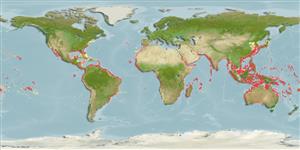>
Carangiformes (Jacks) >
Carangidae (Jacks and pompanos) > Caranginae
Etymology: Alectis: One of three Erinyes in the Greek mythology; daughter of Acheronte with a terrible rage.
More on author: Bloch.
Environment: milieu / climate zone / depth range / distribution range
Écologie
marin récifal; profondeur 60 - 100 m (Ref. 37816). Subtropical; 42°N - 34°S, 180°W - 180°E
Circumglobal in tropical, subtropical and temperate seas. Western Atlantic: Massachusetts, USA and Bermuda to Santos, Brazil; throughout the Caribbean Sea and the Gulf of Mexico (Ref. 9626). Eastern Atlantic: Senegal to Congo. Western Indian Ocean: Red Sea to Algoa Bay, South Africa and to Sri Lanka (Ref. 3197, 3287). Eastern Pacific: Mexico to Peru.
Taille / Poids / Âge
Maturity: Lm ? range ? - ? cm
Max length : 150 cm TL mâle / non sexé; (Ref. 30573); common length : 100.0 cm FL mâle / non sexé; (Ref. 30573); poids max. publié: 22.9 kg (Ref. 40637)
Épines dorsales (Total): 7 - 8; Rayons mous dorsaux (Total): 18-22; Épines anales 3; Rayons mous anaux: 15 - 20.
Pelagic in neritic and oceanic waters, sometimes near the bottom (Ref. 5217, 58302). Small juveniles may be found near the shore (Ref. 5217); adults near bottom to depths of 60 m (Ref. 26938). Feed on sedentary or slow moving crustaceans and occasionally feed on small crabs and fishes (Ref. 9283). Juveniles are attractive aquarium fish, but do not do well in captivity (Ref. 12484). Excellent food fish (Ref. 9626); marketed fresh or dried or salted (Ref. 9283).
Life cycle and mating behavior
Maturité | Reproduction | Frai | Œufs | Fécondité | Larves
Paxton, J.R., D.F. Hoese, G.R. Allen and J.E. Hanley, 1989. Pisces. Petromyzontidae to Carangidae. Zoological Catalogue of Australia, Vol. 7. Australian Government Publishing Service, Canberra, 665 p. (Ref. 7300)
Statut dans la liste rouge de l'IUCN (Ref. 130435)
Menace pour l'homme
Reports of ciguatera poisoning (Ref. 31174)
Utilisations par l'homme
Pêcheries: intérêt commercial mineur; pêche sportive: oui; Aquarium: Commercial
Outils
Articles particuliers
Télécharger en XML
Sources Internet
Estimates based on models
Preferred temperature (Ref.
123201): 16.4 - 27.8, mean 24.8 °C (based on 400 cells).
Phylogenetic diversity index (Ref.
82804): PD
50 = 0.6250 [Uniqueness, from 0.5 = low to 2.0 = high].
Bayesian length-weight: a=0.02188 (0.01320 - 0.03627), b=2.84 (2.70 - 2.98), in cm total length, based on LWR estimates for this species & (Sub)family-body (Ref.
93245).
Niveau trophique (Ref.
69278): 4.0 ±0.7 se; based on diet studies.
Résilience (Ref.
120179): Faible, temps minimum de doublement de population : 4,5 à 14 années (Preliminary K or Fecundity.).
Prior r = 0.28, 95% CL = 0.16 - 0.49, Based on 1 stock assessment.
Fishing Vulnerability (Ref.
59153): Very high vulnerability (90 of 100).
Nutrients (Ref.
124155): Calcium = 16.6 [6.6, 29.7] mg/100g; Iron = 0.599 [0.316, 1.256] mg/100g; Protein = 20 [19, 21] %; Omega3 = 0.15 [0.08, 0.29] g/100g; Selenium = 24.9 [9.7, 53.5] μg/100g; VitaminA = 22.8 [5.7, 87.4] μg/100g; Zinc = 0.403 [0.255, 0.614] mg/100g (wet weight);
